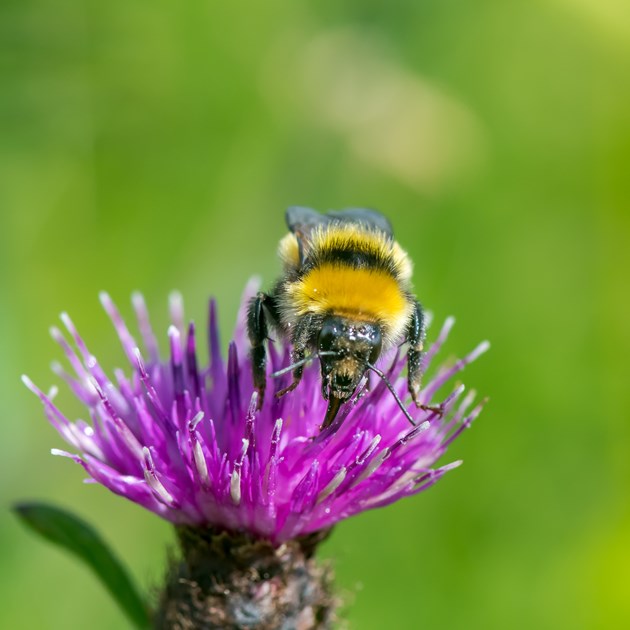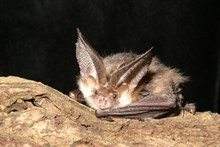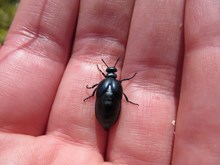14 July, 2023
Multi-species conservation programme arrives in the Inner Hebrides and Argyll

Species on the Edge partnership news release
An innovative and ambitious four-year-long conservation programme, Species on the Edge, has kicked off in the Inner Hebrides and Argyll.
Species on the Edge is a bold new partnership programme of NatureScot and seven conservation charities, dedicated to improving the fortunes of 37 threatened and vulnerable species found along Scotland's coast and islands.
Funded by the National Lottery Heritage Fund, the partnership consists of Amphibian and Reptile Conservation, Bat Conservation Trust, Buglife, Bumblebee Conservation Trust, Butterfly Conservation, NatureScot, Plantlife, and RSPB Scotland.
For the duration of the four-year-long programme, Species on the Edge will be active in seven areas across Scotland: Shetland; the North Coast; the East Coast; the Outer Hebrides; Orkney; Solway; and the Inner Hebrides and Argyll.
The Inner Hebrides and Argyll is the largest of the Species on the Edge project areas, stretching from Skye in the north, out westwards to Tiree, and south to the Mull of Kintyre.
Species on the Edge have a team of four project officers in the area, hosted by RSPB, Buglife, Butterfly Conservation, and Bat Conservation Trust. Together they are delivering activity to conserve 19 vulnerable species in the area including the great yellow bumblebee, medicinal leech, lapwing, curlew, four species of bat, and four species of burnet moth.
Much of the Inner Hebrides and Argyll is home to species that have disappeared from elsewhere in Scotland and it is thanks to generations of crofters, using low intensity agricultural practices, that many of Scotland’s threatened species continue to survive here. A core aspect of Species on the Edge activity in this area is to reinforce the value of High Nature Value (HNV) farming and to work closely with local land managers and crofting communities.
Species on the Edge People Engagement Coordinator, Sarah Duly, said: “People are fundamental to the success of the Species on the Edge programme and the wider effort to protect our vulnerable species. We are offering a range of training and engagement opportunities for people to get involved in practical conservation, citizen science, and creative events and projects. We’ll be listening to and working alongside our local communities to enable more people to connect with their natural heritage.”
Bat Conservation Trust (BCT) has four priority species included in the programme: common and soprano pipistrelles; Daubenton’s bat; and the brown long-eared bat. To date there is very little information about bat populations in the North and West of Scotland, so a large part of BCT’s work will be to carry out extensive monitoring to help understand how bat populations are faring throughout the area. BCT has been working with local community groups to raise awareness of bats and how to protect them and are offering training opportunities to people with an interest in helping to survey bats near them.
Species on the Edge Project Officer Cathryn Baillie said: “Bats make up almost a third of all mammal species in the UK, yet we know so little about them! They are also an indicator species, meaning that they can tell us a lot about the state of the environment. Data for Scottish bat populations is very poor, and we hope that by raising awareness and encouraging more people to look out for these amazing creatures, we can better understand and support them.”
Buglife has three priority species in the Argyll and Inner Hebrides project area: the short-necked oil beetle; medicinal leech; and the northern colletes mining bee. Once found only on Coll, increased awareness and surveying has resulted in short-necked oil beetle populations being discovered all over the Hebrides, with the beetle now also found on Barra, Islay, Tiree and Uist. Short-necked oil beetles are vulnerable to extinction due to their small, scattered populations. Over the next four years, Species on the Edge will be talking to landowners about how they can manage their land to provide the right conditions for the short-necked oil beetle and other invertebrate species.
With only two known populations of medicinal leech in Scotland, Buglife is leading crucial work to support the resilience of existing populations, working with the Kildalton Estate on Islay to secure habitat management for the lochan where the leeches are found and with the Royal Zoological Society of Scotland to establish a captive breeding programme with a view to introducing them to other lochs on Islay.
RSPB has a number of priority species included in the programme: wading birds including the curlew and lapwing, and migratory birds such as little terns and Greenland white-fronted geese. RSPB is also leading work on Coll and Tiree to monitor populations of one of the rarest UK bumblebees, the great yellow bumblebee.
The west coast of Scotland and the Inner Hebrides are home to several rare moths including the slender Scotch burnet, New Forest burnet, transparent burnet and the Talisker burnet. Conservation work, led by Butterfly Conservation, will focus on removing invasive species and working with landowners to achieve levels of grazing beneficial to the moths. Surveys so far this season have shown the presence of the burnet moths on Mull, Ulva, Gometra, Skye, Eigg, and mainland Argyll.
Species on the Edge are also working with Islay veterinary practice who are trialling a new technology with local livestock owners, using image-based software to test livestock for worms and fluke accurately and quickly, increasing efficacy and reducing overall use of veterinary medicines. Use of veterinary medicines negatively impact on the number of larvae found in livestock faeces. These larvae are an important food source for many species. Testing livestock and reducing use of veterinary medicines will help to improve soil health and increase abundance of dung invertebrates. The testing also benefits farmers, improving animal welfare and potentially reducing costs through reduction in treatment.
Species on the Edge will be at the following shows in July and August:
- Tiree Agricultural Show – 21st July
- Bunessan Show on Isle of Mull – 4th August
- Skye Agricultural Show – 5th August
- Salen show on Isle of Mull – 10th August
- Islay, Jura and Colonsay – 10th August
To keep up to date with the Species on the Edge programme, go to the website: www.speciesontheedge.co.uk and follow along on Twitter @SpeciesEdge and on Facebook @SpeciesontheEdge.
You can also sign up to the Species on the Edge mailing list: http://eepurl.com/isDe16
Contact information
- Name
- NatureScot Media
- Telephone
- 0131 316 2655
- media@nature.scot
Notes to editors
The Amphibian and Reptile Conservation Trust (ARC) is a national wildlife charity focusing on toads, frogs, newts, snakes, lizards and marine turtles. ARC conserves amphibians and reptiles, and the habitats on which they depend, to protect them for future generations. The Trust runs species recovery programmes, monitoring, scientific research, advocacy, outreach and regional projects. ARC owns 24 nature reserves and manages 80, covering 1,900 hectares, and works with a wide range of partner organisations, volunteers and specialists. ARC continues a 50-year history of reptile and amphibian conservation. The charity was established in June 2009 by the Herpetological Conservation Trust (HCT), which was formed in 1989. HCT grew out of the British Herpetological Society’s Conservation Committee, formed in 1969. For more information visit www.arc-trust.org
The Bat Conservation Trust is the leading non-governmental organisation in the United Kingdom solely devoted to the conservation of bats and the landscapes on which they rely. The breadth and depth of our work is driven by our vision of a world rich in wildlife where bats and people thrive together. Through monitoring and direct conservation action we can secure the future of our bat species in Scotland.
Buglife - The Invertebrate Conservation Trust is the only charity in Europe devoted to the conservation of all invertebrates. Our aim is to halt the extinction of invertebrate species and to achieve sustainable populations of invertebrates across the UK. We are working hard to achieve this through: Undertaking practical conservation projects that will contribute to achieving our aim. Promoting the environmental importance of invertebrates and raising awareness about the challenges to their survival. Assisting in the development of legislation and policy that will ensure the conservation of invertebrates. Developing and disseminating knowledge about how to conserve invertebrates. Encouraging and supporting invertebrate conservation initiatives by other organisations in the UK, Europe and worldwide. Further information is available on Buglife’s website at www.buglife.org.uk, follow us on Twitter: @BuglifeScotland and ‘Like us’ on Facebook: Buglife – The Invertebrate Conservation Trust.
The Bumblebee Conservation Trust is a membership charity that was established in 2006 due to serious concerns about the ‘plight of the bumblebee’. In the last 80 years many bumblebee populations have crashed and two species have become extinct in the UK. The Trust carries out science, conservation, and people engagement projects across the UK www.bumblebeeconservation.org
Butterfly Conservation is the UK charity dedicated to saving butterflies, moths and our environment. Our research provides advice on how to conserve and restore habitats. We run projects to protect more than 100 threatened species and we are involved in conserving hundreds of sites and reserves across the UK.@savebutterflies BC has more than 2200 members living in Scotland where we work closely with local communities, landowners, the Scottish Government, Scottish Natural Heritage and other conservation partners, to safeguard Scotland’s butterflies, moths and their habitats. www.butterfly-conservation.org/scotland
Plantlife is the international conservation charity working to secure a world rich in wild plants and fungi. Founded in 1989, Plantlife has 15,000 members and supporters. Wild plants and fungi are the foundation of all life on Earth. Plantlife enhances, restores, protects and celebrates our natural heritage through working with landowners, other conservation organisations, public and private bodies and the wider public. Plantlife owns 23 nature reserves covering nearly 4,500 acres across England, Scotland and Wales. We were instrumental in the creation of the Global Strategy for Plant Conservation, the Important Plant Area network and we are a registered COP Observer contributing to international conventions on climate and biodiversity. We are governed by a board of 12 trustees and have around 70 staff, located across the UK. We also support a team of 1500 volunteers who work in the field, at events and in our offices. Our Patron is The former Prince of Wales. See www.plantlife.org.uk for more information.
RSPB Scotland is part of the RSPB, the UK’s largest nature conservation charity. Protecting habitats, saving species and helping to end the nature and climate emergency. Nature is in crisis. Together we can save it.
NatureScot is Scotland's nature agency. We work to enhance our natural environment in Scotland and inspire everyone to care more about it. Our priority is a nature-rich future for Scotland and an effective response to the climate emergency. For more information, visit our website at www.nature.scot or follow us on X at https://x.com/NatureScot
’S e NatureScot buidheann nàdair na h-Alba. Bidh sinn a’ neartachadh àrainneachd na h-Alba agus a’ brosnachadh dhaoine gu barrachd suim a chur ann an nàdar. Tha e mar phrìomhachas againn gum bi nàdar na h-Alba beairteach agus gun dèilig sinn gu h-èifeachdach le èiginn na gnàth-shìde. Tha an tuilleadh fiosrachaidh aig www.nature.scot no air X aig https://x.com/NatureScot




